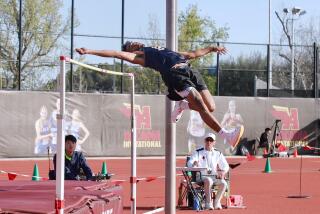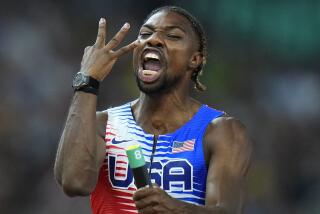He Offers Triple Value : In Europe, Track and Field Promoters Have Learned They Can Bank on Willie
- Share via
When Bill Veeck owned the Chicago White Sox, he occasionally commissioned Max Patkin, the clown prince of baseball, to entertain crowds before games at Comiskey Park.
A contortionist, a magician and a former player, Patkin did tricks with baseballs and his body that never failed to amuse. But when the game began, Patkin retired to the dugout to watch.
Bill Veeck would have loved Willie Banks. Like Patkin, Banks also is an entertainer. He jokes, gestures, dances and leads cheers until he has the attention of everyone at track and field meets.
Unlike Patkin, however, Banks doesn’t leave the field when the action starts.
This clown can jump. Banks, 30, holds the world record of 58 feet 11 1/2 inches in the triple jump and has his heart set on becoming the first man to break 60 feet.
They don’t ask Kareem Abdul-Jabbar to do stand-up comedy. They don’t ask Peewee Herman to triple jump. But Banks does both, always leaving them laughing. This gift has made him one of the most popular athletes throughout the Orient and Europe, Eastern and Western.
So, how come Banks can walk down the streets near his home in Westwood and not be recognized, even when he’s wearing his “Tell ‘em Willie Boy is Here” T-shirt?
Not long ago, he often was stopped and asked for his autograph by people throughout the United States who recognized him as an athlete. They thought he was Edwin Moses. So, Banks shaved his beard.
“That really helped,” he said. “Now, no one asks for my autograph, at all.”
In a meet at Modesto last Saturday, Banks had to announce to the crowd that the triple jump was in progress.
“If you want a big jump, let me know,” Banks said. “If you don’t, keep sitting on your hands.”
Banks is prepared to do the same thing Saturday in the Pepsi Invitational at UCLA’s Drake Stadium, even though he was an All-American at UCLA and should be better received there than in, say, Budapest. But he’s not.
Two years ago at the Pepsi meet, Banks called on every trick in his book to get the crowd started. When he finally began to hear some response, the triple jumpers were told they would have half as many jumps as usual because network television was ready for the long jump, featuring Carl Lewis.
If that happened during a meet in Zurich, Cologne or Stockholm, there would be a riot.
For European promoters, having Banks in their meets is money in their banks. That means money for his bank. He won’t reveal how much he is paid for appearances, but he said the man who negotiates his contracts told him recently that the only four track athletes who earn more money in Europe are Said Aouita, Steve Cram, Lewis and Moses.
The promoters get their money’s worth.
“Now for the Weee-leee Banks Show,” the public address announcer said when the triple jumpers stepped onto the track two years ago in Budapest. From the reaction of the people in the crowd, particularly the younger ones, one would have thought Michael Jackson had appeared.
Banks didn’t disappoint, amusing the crowd into the early evening as the triple jump competition outlasted all of the other events.
When it was completed, dozens of children and teen-agers ran onto the field and began chasing Banks, who playfully avoided them as if he were in a game of tag. Several followed him out of the stadium, through the parking lot and to the door of his nearby hotel, where he stopped to chat with them, even though they couldn’t understand anything he was saying.
“I compare it to being a jazz musician,” the gregarious Banks said during an interview this week. “The roots of jazz music are in this country, but you can’t find many of the best albums in the record stores here. There’s no market. But if you go to Europe and Japan, those albums are popular.
“So, what do the jazz musicians do? They go to Europe and Japan. They go to their public. It’s the same thing with me. Why should I hang out here if my public is there?”
Banks had no public until 1981, when he learned before a meet in Stockholm that the triple jump had been canceled for the remainder of the European season.
“I asked the promoter of one of the big European meets about it,” Banks said. “He said the triple jump didn’t bring people in and that it was boring. I thought, ‘OK, I’ll show you.’ But I had no idea what I was going to do.”
One option would have been to quit the sport and concentrate on passing the California bar exam, something the UCLA law school graduate has yet to do. He expects to hear the results later this month from his fourth attempt.
Instead, he saved the triple jump from extinction.
“Before the competition started in Stockholm, I got all the triple jumpers together and told them this was our last chance in Europe,” he said. “I told them I wanted to see some personal bests and some world records. They looked at me like I was some kind of idiot.”
Then, when the competition began, the first six triple jumpers fouled.
“Man, this is a boring event,” Banks said to himself.
While warming up for his first jump, Banks caught the attention of the crowd in front of the triple jump runway. Wearing his headphones, and trying to get loose, he was doing a dance called the gigolo to the music of the Funkadelics when he noticed the crowd mimicking him.
“When it’s my turn to jump, I put my head down, clench my fists and then clap three times,” he said. “This time, when I clapped, so did the people in the stands. So, I grinned and clapped three times again. So did they. Then I waved and ran down the runway. I jumped 55-3 1/2, which was only a few centimeters short of the Swedish national record. I was dancing and blowing kisses to the crowd.”
Before his next jump, Banks noticed that his audience had extended to the section in front of the triple jump pit.
“I started clapping and screaming and stuff,” he said. “This time, I jumped 56 feet, which was 10 centimeters short of the stadium record, and everyone on that side of the stadium was watching me.”
That wasn’t good enough for Banks, who ran to the other side of the stadium and yelled, “What’s the matter with you?”
By the time he jumped for the fifth time, the crowd on both sides of the stadium was focused on the triple jump.
“Everyone was going nuts, including me,” he said.
His fifth jump was 56-10 3/4, surpassing the stadium record.
“I decided then it was time for my victory lap,” he said. “As I ran around the track, the people in each section would stand and clap. It was like the wave.”
On his final jump, he jumped 57-7, a half-inch short of his American record.
Several spectators bolted from their seats and carried him around the infield on their shoulders.
Banks learned moments later that the triple jump had been added to the schedules of the other European meets.
“The Weee-leee Banks Show” was born.
“Track meets should be fun for the fans,” he said. “This isn’t golf or tennis. The fans should be involved.”
No one has told him lately that the triple jump is boring, although he was told by his former club, Nike’s Athletics West, that he was too old to continue competing after he finished sixth in the Olympics. That was about the same time his former fiancee told him the engagement was off.
Since then, Banks has broken the world record, signed with a different shoe company, Adidas; joined another track club, Mazda, and become engaged again. He and Louise Romo, a middle-distance runner for Cal, have a wedding date in November.
Tell ‘em Willie Boy is still here.
More to Read
Go beyond the scoreboard
Get the latest on L.A.'s teams in the daily Sports Report newsletter.
You may occasionally receive promotional content from the Los Angeles Times.










